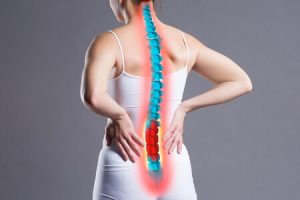
Herniated Disc vs. Spinal Stenosis: Understanding the Difference
If you’re experiencing pain in your back, there are a variety of causes and it can sometimes be difficult to pinpoint exactly what you’re dealing with. Herniated discs and spinal stenosis are two possible causes of back pain. It’s common for people to confuse the two, which can interfere with finding the right treatment.
Herniated Discs
In order to learn the differences between herniated discs and spinal stenosis, it’s best to look at each one individually. Your spine is made up of many individual bones called vertebrae. Between each vertebra is a disc. This disc is made up of a tough exterior with a gel-like center. The discs in your spine absorb pressure and flex to allow for movement without your bones rubbing against each other. A herniated disc occurs when the exterior of the disc is weakened and the center protrudes through the weak points. When this happens, it creates several issues for your spin. A herniated disc can press on nerves and other important tissue. It also causes your spine to fall out of alignment. Symptoms include pain in the arms, shoulders, legs, feet, and back. You may also experience sharp pains when you move. If the herniated disc is pressing on a nerve, it can cause numbness, muscle spasms, and muscle weakness.
Herniated Disc Treatment
When you have a herniated disc, the area around the disc becomes inflamed. This is the body’s natural reaction to injury and illness. However, excessive inflammation can cause more pain and even prevent the injury from healing. The first step of treatment is reducing the inflammation taking place. There are natural ways to reduce inflammation including hot/cold compresses and pain relief medication. Physical therapy can also provide you with exercises to reduce inflammation and encourage your body to naturally heal. If the case is severe, there are also a few options for surgery. At the Nerve and Disc Institute, you can engage in a non-invasive treatment that takes advantage of the body’s natural ability to heal itself.
Spinal Stenosis
The vertebrae in your spine form an opening or column that your spinal cord runs through. Spinal stenosis occurs when the spinal column is too narrow. This can happen at birth or it can develop over time. It can become more common with age as the bones begin to deteriorate. With spinal stenosis, the spinal cord is being compressed and this can result in several symptoms. These symptoms will vary depending on which part of the back is affected. Generally, spinal stenosis causes numbness, a tingling sensation, and muscle weakness.
Spinal Stenosis Treatments
For spinal stenosis, the first course of action is to reduce the symptoms taking place. Muscle relaxers, pain relievers, compresses, and even massages are used to calm the area and prevent continuing symptoms. If the case is severe, surgery is used as an option. Some surgeries offered are minimally invasive with a short recovery time. For more effective treatment, you can seek help at the Nerve and Disc Institute. Here, the goal is to address the root cause of the issue rather than just relieve the symptoms. Addressing the primary cause can fix the issue and prevent future pain.
Preventing Herniated Discs and Spinal Stenosis
A lot of back issues, including herniated discs and spinal stenosis, can be prevented when you’re conscious of your lifestyle. As you age, your body is more worn down and you are more susceptible to injuries. To prevent back issues, you should do your best to maintain physical activity. This keeps your body stronger and it improves the flexibility of your back. Avoiding excess weight can reduce the pressure on your spine. When you take care of your body, there is a lower risk of injury.
Back issues can cause a lot of pain and discomfort that disrupt your daily life. If you’re experiencing either of these issues, you should seek treatment immediately. Doing so can provide you with relief and prevent the issue from worsening.
The Nerve and Disc Institute offers a revolutionary treatment program that can provide you with relief. Click here to learn more about herniated discs and how treatment can help you.